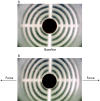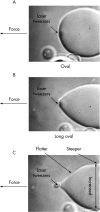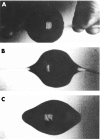Topographical changes of biconvex objects during equatorial traction: an analogy for accommodation of the human lens
- PMID: 16837546
- PMCID: PMC2095551
- DOI: 10.1136/bjo.2006.094888
Topographical changes of biconvex objects during equatorial traction: an analogy for accommodation of the human lens
Abstract
Aim: To assess and compare the changes in shape of encapsulated biconvex structures undergoing equatorial traction with those changes reported in the human lens during accommodation.
Methods: Equatorial traction was applied to several different biconvex structures: air, water, and gel filled mylar and rubber balloons and spherical vesicles. In the vesicles, traction was applied externally, using optical tweezers, or from within, by the assembly of encapsulated microtubules. The shape changes were recorded photographically and the change in central radius of curvature of water filled mylar balloons was quantified.
Results: Whenever an outward equatorial force was applied to the long axis of long oval biconvex objects, where the minor to major axis ratio was </=0.6, the central surfaces steepened and the peripheral surfaces flattened. Similar changes in the shape of the lens have been reported during human in vivo accommodation.
Conclusions: All biconvex structures that have been studied demonstrate similar shape changes in response to equatorial traction. This effect is independent of capsular thickness. The consistent observation of this physical change in the configuration of biconvex structures in response to outward equatorial force suggests that this may be a universal response of biconvex structures, also applicable to the human lens undergoing accommodation.
Conflict of interest statement
Competing interests: Dr Schachar has a financial interest in the surgical reversal of presbyopia.
Similar articles
-
Analysis of human crystalline lens accommodation.J Biomech. 2006;39(4):672-80. doi: 10.1016/j.jbiomech.2005.01.017. J Biomech. 2006. PMID: 16023655
-
Constant volume of the human lens and decrease in surface area of the capsular bag during accommodation: an MRI and Scheimpflug study.Invest Ophthalmol Vis Sci. 2009 Jan;50(1):281-9. doi: 10.1167/iovs.08-2124. Epub 2008 Aug 1. Invest Ophthalmol Vis Sci. 2009. PMID: 18676625
-
Equatorial wrinkles in the human lens capsule.Exp Eye Res. 2017 Jun;159:77-86. doi: 10.1016/j.exer.2017.02.004. Epub 2017 Feb 12. Exp Eye Res. 2017. PMID: 28202286
-
Biomechanics of the human lens and accommodative system: Functional relevance to physiological states.Prog Retin Eye Res. 2019 Jul;71:114-131. doi: 10.1016/j.preteyeres.2018.11.004. Epub 2018 Nov 12. Prog Retin Eye Res. 2019. PMID: 30439450 Review.
-
Visual accommodation in vertebrates: mechanisms, physiological response and stimuli.J Comp Physiol A Neuroethol Sens Neural Behav Physiol. 2006 Feb;192(2):97-111. doi: 10.1007/s00359-005-0049-6. Epub 2005 Sep 20. J Comp Physiol A Neuroethol Sens Neural Behav Physiol. 2006. PMID: 16172892 Review.
Cited by
-
The evolution of mechanism of accommodation and a novel hypothesis.Graefes Arch Clin Exp Ophthalmol. 2023 Nov;261(11):3083-3095. doi: 10.1007/s00417-023-06045-w. Epub 2023 Apr 27. Graefes Arch Clin Exp Ophthalmol. 2023. PMID: 37103620 Review.
-
Model of zonular forces on the lens capsule during accommodation.Sci Rep. 2024 Mar 11;14(1):5896. doi: 10.1038/s41598-024-56563-8. Sci Rep. 2024. PMID: 38467700 Free PMC article.
-
The relationship between accommodative amplitude and the ratio of central lens thickness to its equatorial diameter in vertebrate eyes.Br J Ophthalmol. 2007 Jun;91(6):812-7. doi: 10.1136/bjo.2006.107524. Epub 2006 Oct 18. Br J Ophthalmol. 2007. PMID: 17050574 Free PMC article.
-
The effect of human in vivo accommodation on crystalline lens stability.Br J Ophthalmol. 2007 Jun;91(6):790-3. doi: 10.1136/bjo.2006.110791. Epub 2007 Jan 10. Br J Ophthalmol. 2007. PMID: 17215266 Free PMC article.
-
Isolated human lens interferometric surface radius of curvatures: Implications for the mechanism of accommodation.PLoS One. 2025 Jun 24;20(6):e0327028. doi: 10.1371/journal.pone.0327028. eCollection 2025. PLoS One. 2025. PMID: 40554627 Free PMC article.
References
-
- Young T. On the mechanism of the eye. Phil Trans R Soc 18019223–88.
-
- von Helmholtz H. Uber die akkommodation des auges. Arch Ophthalmol 184411–74.
-
- Tscherning M.Physiological optics, second edition. Philadelphia: The Keystone 1904160–189.
-
- Fincham E F. Mechanism of accommodation. Br J Ophthalmol 19378(suppl)2–80.
-
- Weale R A.A biography of the eye: development, growth, age. London: HK Lewis, 1982
MeSH terms
LinkOut - more resources
Full Text Sources







